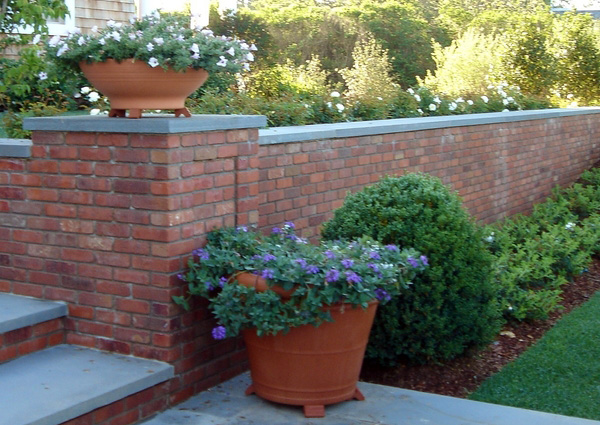
Whether it’s a cozy cottage or a large sprawling estate replete with pool and tennis courts, homes that utilize brick or stone veneers often create elegant, classic curb appeal. And several local masons are in the business of doing precisely that: helping homeowners create the castle-like look that ups resale value and increases aesthetics doublefold.
Southampton Masonry in Southampton has been providing Long Island builders and homeowners with mason supplies since 1976. The company, owned by Tony Toscano, carries an extensive selection of brick and stone options, according to manager Mike Hakal.
“The great thing about natural brick or stone is that it is extremely long lasting and durable,” said Mr. Hakal. “Brick and stone looks beautiful and it requires minimal maintenance.”
Among the more popular options available at Southampton Masonry, Mr. Hakal noted during a recent interview, is the mosaic stone veneer. Mosaic stones come in a variety of colors and styles, blended greys and grey-blues, chalky reds or sand most prominent among them. Typically, mosaic stones are also relatively thin.
“This is a very technical style—stones are sized just so and must be laid with care to achieve the best look,” Mr. Hakal added.
Also popular at Southampton Masonry is a style of stone dubbed “ashlar.” Ashlar stones are large and rectangular in shape and are frequently sculpted by masons to have 90-degree “square” edges with smooth faces. Mr. Hakal also noted that he finds the grain in ashlar to be particularly appealing.
Most of the materials found at the Southampton business are shipped to the East End from all over the country. Additionally, some goods come from France, Italy, India and other points abroad. Typically, French and Italian stone is used for paving work. Local materials are also sold at Southampton Masonry; one hot-ticket item is bluestone from upstate New York, which can range in price from $7 to $50 per square foot.
Mason Daniel H. Raynor, who has run his own private masonry company since 1981, said that he finds the native stone available at East Coast Mines in East Quogue to be a favorite choice amongst homeowners who have hired him for masonry work over the years. A particularly popular request he has received is for native stones, which he explained fit with the natural look of the Hamptons.
“Native stones are yellow [in color] and are smooth from having been tumbled around by glaciers millions of years ago. I’ve heard some people refer to them as ‘beach stones’ because they look like any stone you’ve ever seen walking on the beach out here,” Mr. Raynor said.
At M.O.E. Masonry, an installation company in Southampton, Project Manager Jay Lund said that he prefers a dry-stacked bluestone look. Dry-stack stones are arranged without mortar to seal everything into place. However, a lack of mortar does not mean the veneer will be any less durable or long lasting, he said.
Variation in appearance of the dry-stack stones also depends on the placement of joints—the mortar bond which is placed in between bricks, blocks or stones—or the course, which is the setting or arrangement of the materials, Mr. Lund reported.
Mr. Raynor also noted that homeowners can obtain two entirely different looks for the stonework, even using the same material, if the bricks or stones are laid with either a wider or thinner joint. The appearance is also dependent upon the texture of the mix or mortar used, he said, adding that masons also use a variety of tools—one of which might be a horsehair brush, which, when combed over the mixture before it dries completely, adds “something extra.”
If natural stone or brick isn’t a viable option for homeowners, there is always the choice of cultured or faux stone. Depending on whom one asks, whether cultured stone is the better choice is a subject of debate.
The cost margin between natural and cultured or faux stone has greatly narrowed in recent years, Mr. Hakal said. He reported that cultured stone has lost much of its popularity because of the relatively negligible cost difference today.
But there are other basic concerns some masons have when it comes to the faux product.
“Again, natural stone will last basically forever, and though cultured stone will last, it fades or discolors with exposure to water,” Mr. Hakal said.
Mr. Lund agreed. He acknowledged that faux brick or stone has its upside, but overall, cleaning and maintaining faux material is much harder.
“It just doesn’t wipe clean like natural stone does,” he said.
Mr. Raynor enthusiastically declared his dislike for cultured stone.
“It’s harder to work with. If you chip it, you see the cement behind it. A real stone isn’t like that,” he said. “Also, it’s just cement with an iron oxide paint overlaid, and that takes away from the quality of the look, I think. Not to mention, at least for me, someone who works as a mason, each brick or stone looks exactly the same—there isn’t any unique quality to it. But this isn’t always the case, just most of the time, I’d say.”
Whether homeowners opt for the real thing or not is no matter to most masons. After all, it’s more about a person’s preferences, most of those interviewed agreed. What really matters is the bottom line and that is, if, after installing brick or stone veneers, the homeowners feel like they are the kings or queens of their newly improved castle.